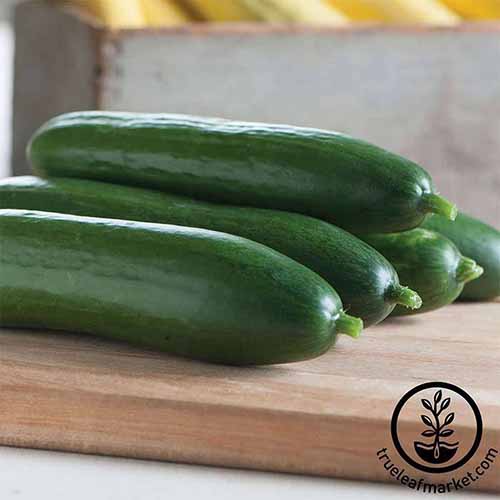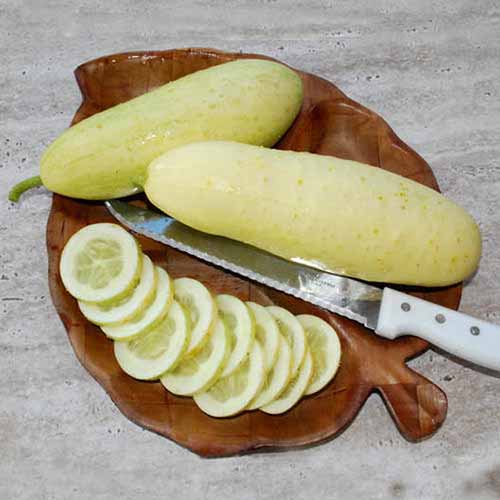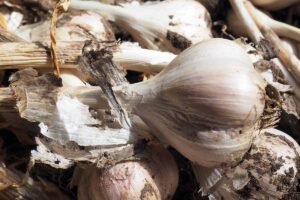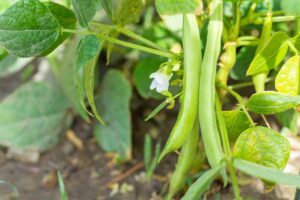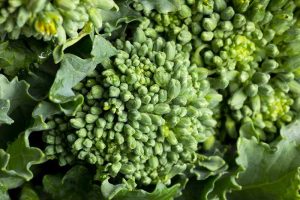Don’t you just love win-win situations?
Choosing which type of cucumber plant to grow in your garden is one of those times when it’s hard to go wrong.
Each category of Cucumis sativus, as these vegetables are known botanically, offers an abundance of rewards and benefits.
From slicers to picklers, hybrids to heirlooms, vines to bush types, there will probably be at least one that will suit your growing needs.
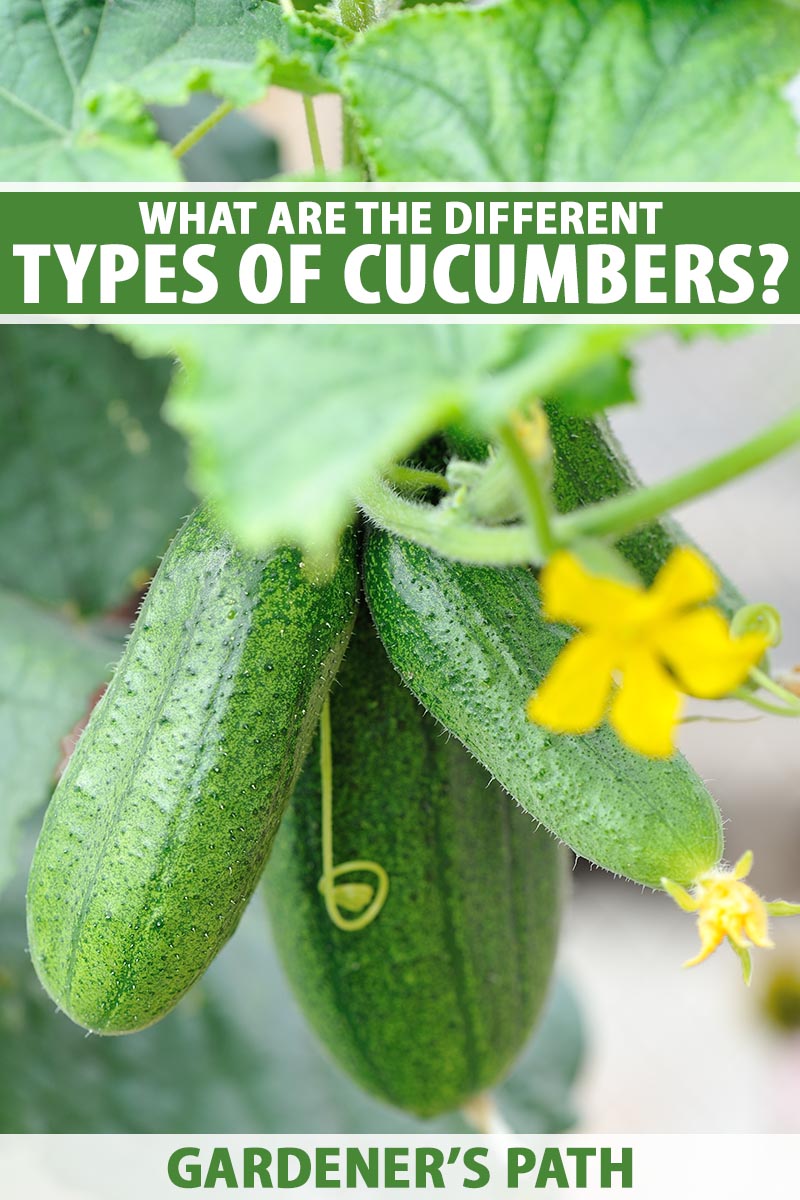
We link to vendors to help you find relevant products. If you buy from one of our links, we may earn a commission.
But first, it pays to know about all the possibilities, at least in general terms. There may be a super-helpful trait you’re not aware of, or a whole group that would not do well for you at all.
To help you get sorted, here’s what I’ll cover:
What You’ll Learn
Slicing vs. Pickling
When you join the merry band of cucumber gardeners, the first distinction you typically come across is based on whether the fruits a plant produces lend themselves more to “slicing” or to “pickling.”
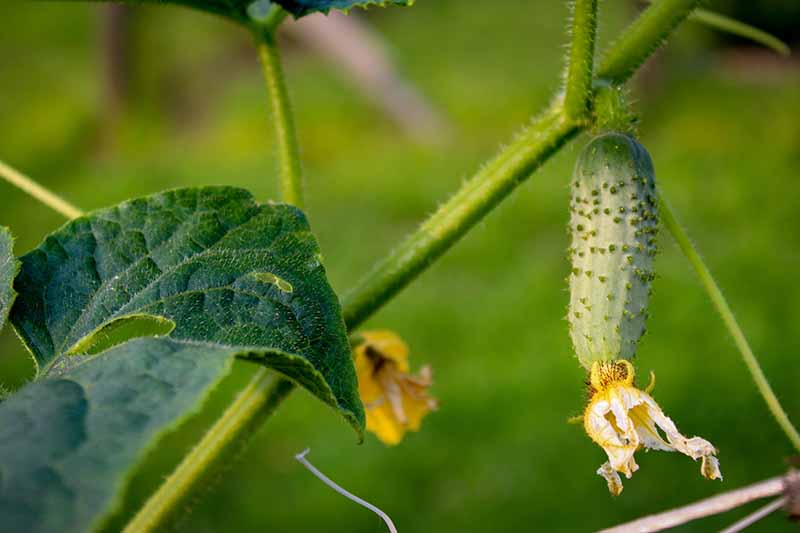
The slicing types have thicker, dark green skins. These can be bitter, so people sometimes peel them before serving. They go into salads or are eaten fresh, maybe sliced into sticks with a bit of onion dip.
Slicing plants typically produce a bumper crop of fruits harvested when they’re between seven and 10 inches long, depending on the cultivar.
Pickling varieties produce heavily, too, but since they’re not as large as slicers, you usually don’t get as many pounds from a single plant.
They’re best harvested at three to five inches long, or even shorter for gherkin varieties. The fruits also have skin that stays crisp after pickling, and fewer – but larger – spines than slicers. Their skins aren’t bitter.
Contrary to what you might assume, pickling cucumbers are also delicious for fresh eating. They have smaller seeds than slicers, a sweet flavor, and skins that don’t get tough unless you let them get too mature and grow too large on the vine.
Pollination Requirements
Another way gardeners and researchers categorize these plants is based on their flowering tendencies, and whether they require pollination to produce.
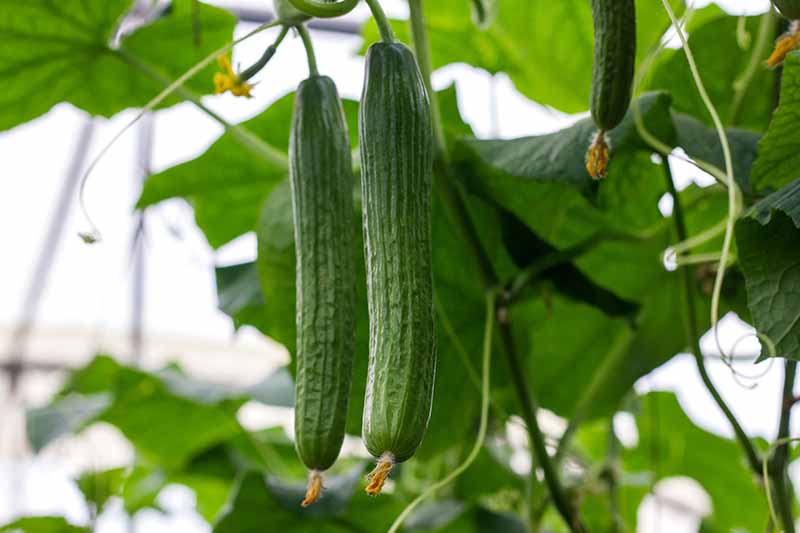
Two types may rely on insects to pollinate their flowers. The “monoecious” ones produce male and female flowers on a single plant, while “gynoecious” varieties have flowers that are nearly all female.
Monoecious types are always open-pollinated, while some gynoecious ones are and some aren’t.
Most gynoecious varieties have been bred to be high-yielding and to produce quickly. They may or may not need pollinators to fruit.
You won’t need to worry about whether any gynoecious varieties you might purchase have access to male flowers if they’re reliant on pollination, though. Instead, seed suppliers commonly mix the ones that do need pollinating with a small percentage of a monoecious seed, and that takes care of it.
But you do need to grow at least seven plants of a gynoecious variety to ensure one of them is monoecious and can fertilize the others, according to Al Burkett, a cucumber breeder with Peto Sluis Seed Company in Woodland, California.
Burkett addressed cucumber pollination as part of the National Gardening Association’s Learning Library coverage.
To be on the safe side, anyone who plans to grow only a couple of plants should choose a cultivar that’s “parthenocarpic.” Those varieties produce fruit without pollination.
Parthenocarpic types are sometimes referred to as “self-pollinating,” though that’s not strictly true. They can also be pollinated by insects carrying pollen from other cucumber flowers, but they’ll have fruit regardless.
If they’re not exposed to pollen from the flowers of the other types, they’ll produce cucumbers that are virtually seedless.
This makes the seeds scarce, so they’re usually more expensive to purchase to grow in your garden. They’re also a bit harder to find, though a couple of types are widely available.
One of the most popular parthenocarpic varieties for home growers is ‘Diva,’ a hybrid variety which produces thin-skinned fruits ready for harvest at five to seven inches long.
You can find seeds in packets of 12 to 1,000 available from True Leaf Market.
But if your best option is growing cucumbers in a greenhouse or cold frame, you definitely want a type that is both parthenocarpic and gynoecious. That assures your pick will have lots of female flowers but won’t require insects to produce fruit.
A standout variety in this category is ‘Sweet Success,’ an All-America Selections winner that yields smooth-skinned, dark green fruits that reach 12 inches long at maturity.

‘Sweet Success’ seeds are available from Burpee via Amazon.
Bush vs. Vining
Cucumber plants can be sprawling vines that will grow from four to 12 or even 15 feet long. There are also “bush” types that take up just a couple of square feet in the garden. They may grow only two feet tall, and spread just 18 inches.
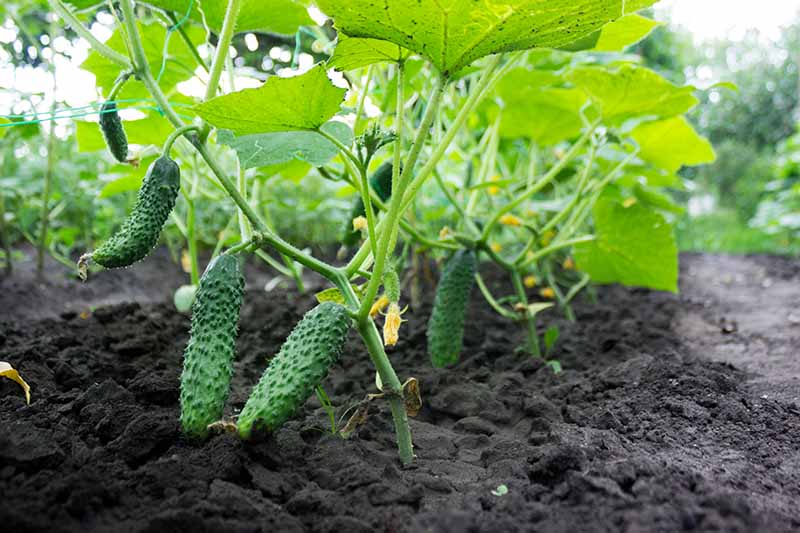
It’s counterintuitive, but sometimes the vines make better use of small garden spaces. You can plant them just one foot apart if you offer ample support in the form of a trellis or fence.
Within the bush category there are also “dwarf” varieties. They’ve been bred to produce in container gardens or small spaces.
One example is ‘Spacemaster.’ It grows to just six or eight inches tall and spreads 26 inches, but still produces eight-inch slicing cucumbers.
Learn more about ‘Spacemaster’ and 32 more of the best vining and bush cucumbers in our guide.
Thin-Skinned and Burpless Cucumbers
Garden-variety cukes do produce a fair amount of a compound known as cucurbitacin, which can make them bitter.
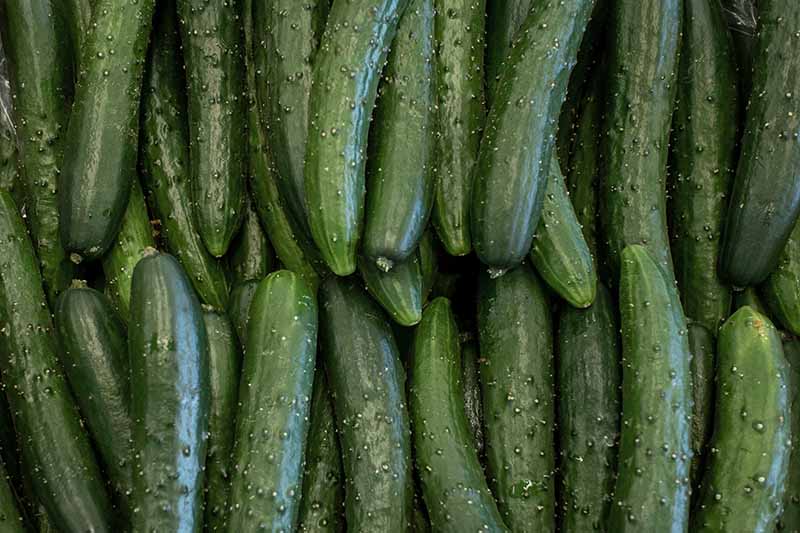
The compound is found in the highest concentration in the skins and stems, and it may be the source of the indigestion some experience after eating these crunchy vegetables.
Decades ago, “burpless” varieties were introduced in an attempt to address this drawback. Asian cucumbers with thinner skins and less cucurbitacin were the first to be marketed as “burpless” in the US.
If you’re a stickler, it’s worth mentioning that while most of these varieties aren’t as bitter or as likely to cause indigestion as some other homegrown types, they don’t always provide a burpless experience.
Gardeners may also use the term “burpless” casually to mean a variety that has few seeds and thin skins. If you’re on a quest for easy-to-digest homegrown cucumbers, consider both burpless types and those referred to as “bitterfree.”
Some of the thin-skinned types – burpless or not – include extra-long European varieties with no spines, and spiny, foot-long Asian slicers.
A shorter variety goes by the names Persian or Lebanese, with ‘Beit Alpha’ being a specific cultivar. These are the same smooth-skinned fruits you so often see stacked in small plastic bags in big grocery stores.
Specialty Cucumbers
There’s a catch-all category that’s usually called “Novelty” or “Specialty” online or in seed catalogs. That’s where you’ll find some of the best conversation starters!
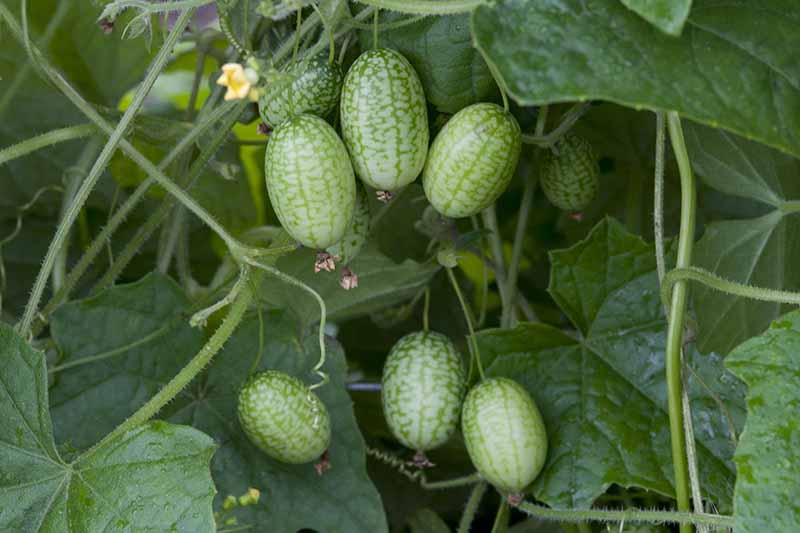
Some of these are merely unusual types of C. sativus, like the sweet-bitter fleshed ‘Brown Russian,’ which resembles nothing so much as a pickle-shaped baking potato.
There’s also the open-pollinated ‘Painted Serpent’ or ’Striped Armenian.’
With striped, curved fruits picked at 15 inches long, it’s commonly referred to as a cuke, though it’s actually a different species, C. melo.
You can find seeds available from Eden Brothers.
One cute novelty variety, Melothria scabra, the ‘Mexican Sour Gherkin,’ aka cucamelon or mouse melon, is used in the same way, but is both a different genus and species from other pickling varieties.
Hybrids vs. Heirlooms
Most of the previous categories of cucumber plant will fit into one or the other of these categories.
Many modern varieties, and all of the parthenocarpic types, are hybrids. This means they were bred in controlled environments to produce certain traits.
One thing to be aware of is that hybrids will not necessarily be the same as the parent plant, or produce the same fruit, if you save the seeds to grow next year.
If you are determined to save seeds to swap or plant next year, open-pollinated heirlooms are your only option.
As for what that label means, many authorities classify a vegetable as an heirloom only if it was developed before 1951.
Some unique cultivars have a legacy that extends much further, and were introduced centuries ago.
“All heirloom plants are open pollinated – meaning that seed from these varieties can be saved each year by home gardeners and will grow “true to type” from seed each time,” Browning added.
“In other words, plants grown from seed will look exactly like the parent plant did, having the same plant size and growth habit, as well as fruit size, color, and flavor.”
Heirlooms often have interesting people as part of their history, like ‘White Wonder.’
This cultivar looks like a newfangled variety with its easy-to-spot creamy-skinned fruits. But it was first introduced by W. Atlee Burpee, who founded Burpee, in 1893.
He came from a highbrow family descended from French Canadian Huguenots, but still became a hobbyist breeder of poultry and plants, meeting with international success when he was just 16!
Burpee rebelled against his father’s idea that he become a medical doctor, instead going into the agriculture business and becoming an early proponent of improved plant seeds.
He came out with ‘White Wonder’ the year before two other Burpee innovations, ‘Iceberg’ lettuce and the ‘Stringless Green Pod Bean.’
‘White Wonder’ is a vining variety that produces cream-colored, six- to eight-inch fruits.
Seeds are available from Eden Brothers in a variety of packet sizes.
The varieties that have been passed down from generation to generation may also taste better than their hybrid counterparts, or at least taste more like the fruits you remember from childhood or a relative’s garden.
But hybrids have been bred to solve problems that stand in the way of successfully growing a crop. Cucumber hybrids are an especially valuable option, because they are resistant to many diseases that can ravage heirloom plants, such as fusarium wilt.
Many growers and seed swapping organizations will note if an heirloom is particularly susceptible to a certain disease, or more than one. If the disease is prominent in your growing area, you should avoid planting that cultivar.
And to be on the safe side, when you grow heirlooms, be extra diligent with measures that will protect them from disease. These can include crop rotation, interplanting, and providing ample spacing.
Which Cuke will Make the Cut for Your Garden Team?
There’s one more thing I’d like to emphasize about the extravagant number of selections described here:
Don’t let it throw you!
It’s pretty simple to make a quick choice of either the pickling or slicing category, and then narrow that to a bush or vining variety, and go about your day.
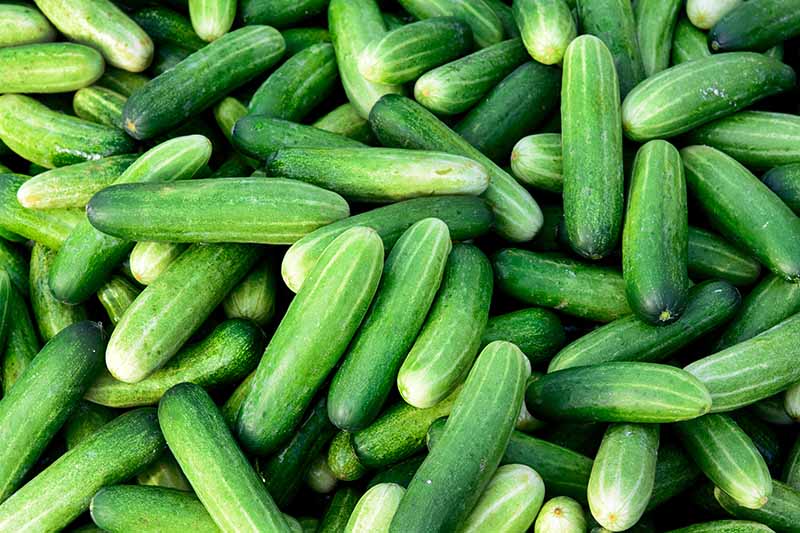
Or you can savor the choice, look at all the types, and then spend hours more choosing a cultivar that has the right name, the perfect look, and a great back story.
What about you? What’s your approach to picking cucumbers to grow in the garden? Share any food for thought in the comments section below, or any questions.
And for more information about growing cucumbers in your garden, check out these guides next:
